Cactuses reveal another side in spring, when beautiful flowers in vibrant colors appear on these uniquely shaped plants with sharp spines. Flowers are as much a part of a cactus’ growth cycle as they are for a flowering perennial or shrub. Let’s take a journey to see some favorite flowering cactuses that thrive in many arid regions of the United States.
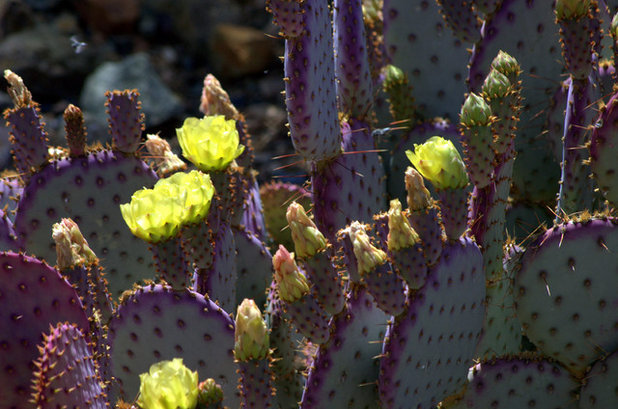
Noelle Johnson Landscape Consulting
The following cactuses are extremely drought-tolerant and able to survive on natural rainfall once established. A newly planted cactus appreciates monthly water in summer. Cactuses aren’t picky about soil as long as it is well-drained, and they are best planted in spring, after the danger of frost has passed, or in early fall.
Keep irrigated plants several feet away from a cactus to avoid problems with rot or an overweight cactus, which can fall over.
Santa Rita Prickly Pear(
Opuntia violacea santa-rita)
Santa Rita prickly pear adds welcome color contrast to the landscape throughout the year, with gray-blue pads edged with purple. The purple coloring deepens during cold weather as well as in drought conditions. Yellow flowers appear from April into May.
Where it will grow: Hardy to 15 degrees Fahrenheit, or minus 9.4 degrees Celsius (USDA Zone 8; find your zone)
Origin: Native to Arizona, New Mexico and Texas and south through Chihuahua, Mexico
Light requirement: Full sun
Mature size: 2 to 5 feet tall and wide
See how to grow Santa Rita prickly pear
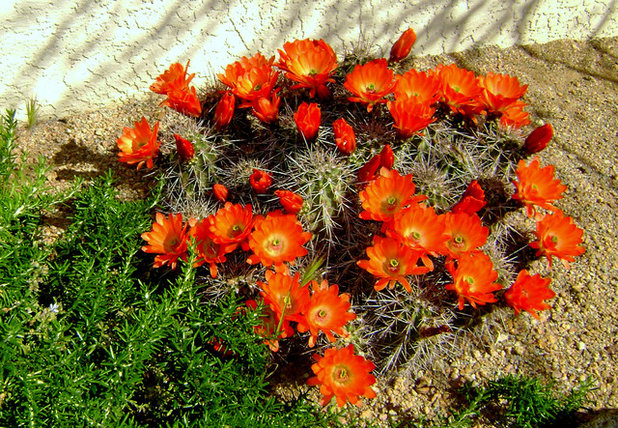
Noelle Johnson Landscape Consulting
Kingcup Cactus(
Echinocereus triglochidiatus)
Bright orange-red flowers almost completely cover this compact cactus when they appear in April and May. The 3-inch-wide flowers appear on top of 10-inch-tall stems. This low-growing cactus can grow as wide as 3 to 4 feet.
Where it will grow: Hardy to -15 degrees Fahrenheit, or minus 26.1 degrees Celsius (Zone 5)
Origin: Native to the desert regions of Arizona, California, Colorado, New Mexico, Texas and Utah
Light requirement: Full sun
Mature size: 10 inches tall with a spread of 3 to 4 feet
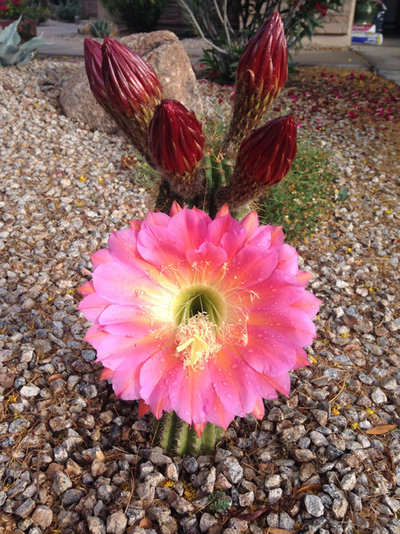
Noelle Johnson Landscape Consulting
Echinopsis(
Echinopsis spp.)
These unassuming cactuses produce flowers that resemble Easter lilies in spring and often again in summer. Truly stunning flowers range in size from 1 inch up to 8 inches across, in shades of pink, orange, yellow and white, depending on the species or hybrid. There are many different species and hybrids of echinopsis, and they are a favorite among collectors. While they can be grown indoors in colder climates, they may not flower.
Where they will grow: Varies, but average hardiness is to 20 degrees Fahrenheit, or minus 6.7 degrees Celsius (Zone 9)
Origin: Native to South America
Light requirement: Full sun; provide filtered afternoon shade in low-desert locations
Mature size: Varies depending on species, but most range from 6 inches to 2 feet tall
Shown: Echinopsis ‘Flying Saucer’
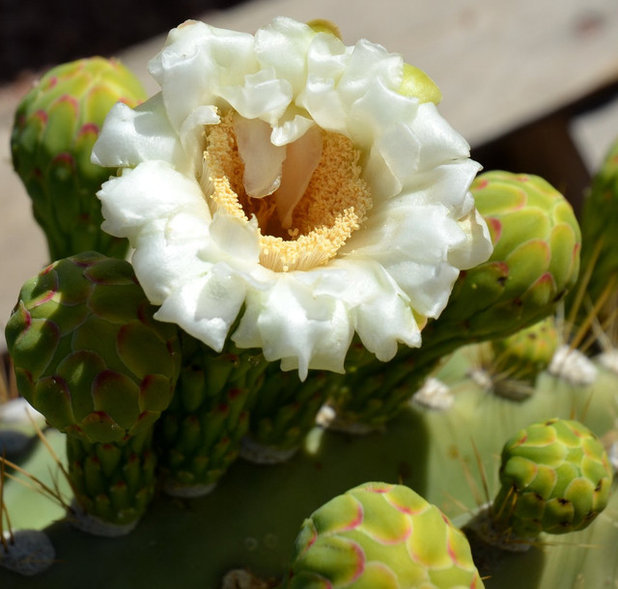
Noelle Johnson Landscape Consulting
Shown: Saguaro flower
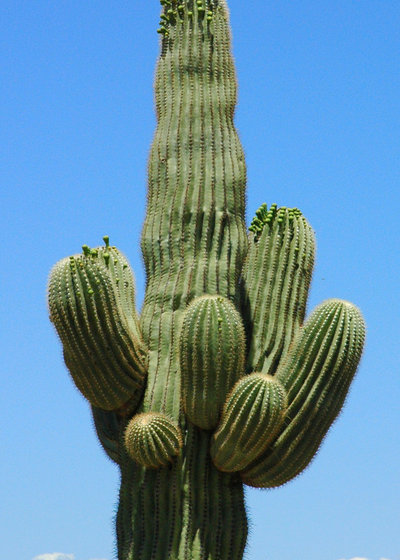
Noelle Johnson Landscape Consulting
Saguaro(
Carnegiea gigantea)
The saguaro is perhaps the most iconic cactus of all, and its flower is the state flower of Arizona. In May, small bumps begin to appear toward the top of mature saguaro specimens at least 70 years old. Flowers edged with white, waxy petals appear, which are pollinated by bats in the evening and by birds and bees during the day. Bright red fruit follows in June, which is a rich source of food and water to birds and mammals.
Where it will grow: Hardy to 20 degrees Fahrenheit, or minus 6.7 degrees Celsius (Zone 9)
Origin: Native to the Sonoran Desert regions of Arizona and Northern Mexico
Light requirement: Full sun
Mature size: Approximately 16 feet tall at a hundred years of age; up to 45 feet tall at 200 years. The larger the saguaro, the more likely it is to flower. (People plant saguaro cactus in a variety of sizes, with spears from 4 feet tall to 20 to 30 feet tall.)
Read more about saguaro cactus
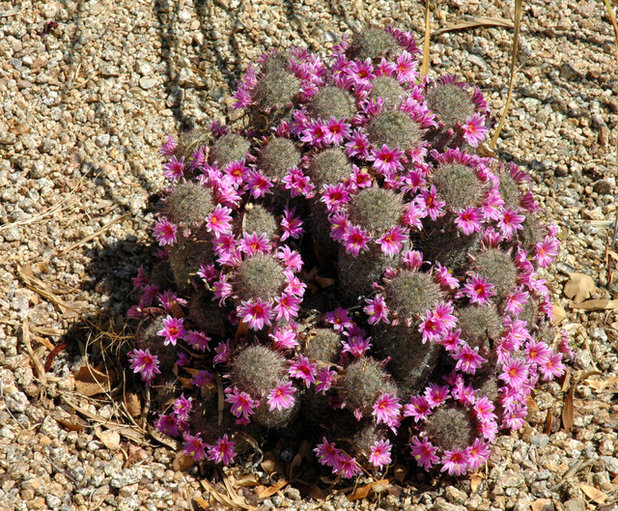
Noelle Johnson Landscape Consulting
Graham’s Nipple Cactus(
Mammillaria grahamii syn.
Mammillaria microcarpa)
A fine netting of spines gives this compact cactus its grayish coloring. A ring of star-shaped flowers circles the top of each small stem. Flowering is a response to summer rains and can repeat throughout the summer.
This little cactus is often found nestled underneath the branches of a nurse plant — a plant that shelters vulnerable cactus seedlings with shade and protection from wildlife until they are large enough to survive on their own — such as triangle bur ragweed (
Ambrosia deltoidea).
Mammillaria grahamii, also called pincushion cactus or
Arizona fishhook, can also be grown indoors and will flower if provided with the right conditions.
Where it will grow: Hardy to 10 degrees Fahrenheit, or minus 12.2 degrees Celsius (Zone 8)
Origin: Native to the Southwest and northern Mexico
Light requirement: Filtered sun
Mature size: 3 to 8 inches tall; cluster can spread to 1 feet wide
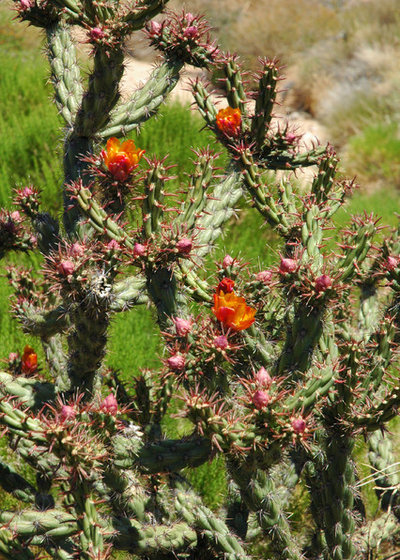
Noelle Johnson Landscape Consulting
Buckhorn Cholla(
Cylindropuntia acanthocarpa syn.
Opuntia acanthocarpa)
The stems of buckhorn cholla grow in a haphazard pattern, so that it roughly resembles a prickly, leafless shrub. It produces flowers that range in color: red, orange, pink and yellow. Usually, each cholla produces flowers that are all the same color, although there are some exceptions.
The stem interiors are woody, and their “skeletons” are highly collectible, although removing them from public lands is prohibited without permission.
Where it will grow: Hardy to 15 degrees Fahrenheit, or minus 9.4 degrees Celsius (Zone 8b)
Origin: Native to the desert regions of Arizona, California, Nevada and Utah
Light requirement: Full sun
Mature size: 3 to 7 feet tall and wide
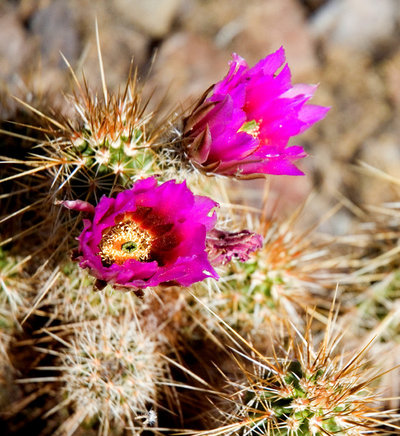
Noelle Johnson Landscape Consulting
Engelmann’s Hedgehog Cactus(
Echinocereus engelmannii)
The spiky stems of Engelmann’s hedgehog cactus can often be seen peeking out from underneath nurse plants, such as triangle bur ragweed, or alongside boulders. Pink or magenta flowers that are 2 inches tall and 3 inches wide appear from spring into early summer.
Where it will grow: Hardy to 10 degrees Fahrenheit, or minus 12.2 degrees Celsius (Zone 8)
Origin: Native to desert regions of Arizona, California, Nevada and Utah, and to northern Mexico
Light requirement: Full sun
Mature size: 10 inches tall, with a spread of 1 foot to 2 feet
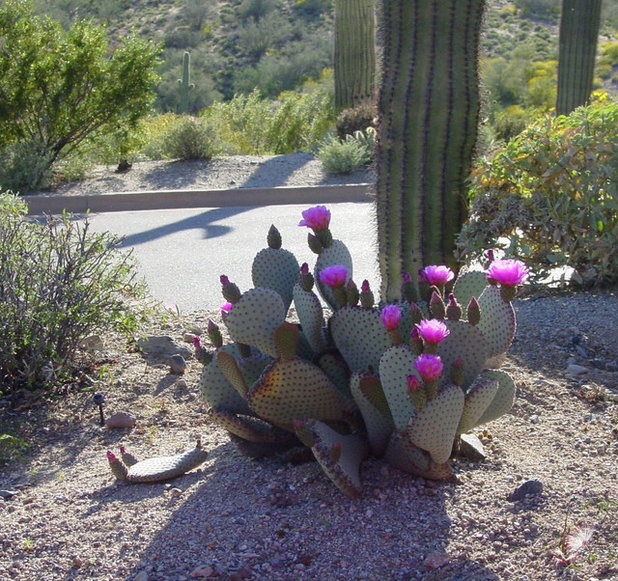
Noelle Johnson Landscape Consulting
Beavertail Prickly Pear(
Opuntia basilaris)
Dark pink flowers are borne aloft gray-green pads that resemble a beaver’s tail. Beavertail prickly pear doesn’t have long spines, like many other prickly species do, but it does have tiny glochids, which can embed themselves in your skin — don’t get too close when admiring its flowers. Unlike some prickly pear species, beavertail prickly pear stays compact, so it won’t become overwhelming in size.
Where it will grow: Hardy to 10 degrees Fahrenheit, or minus 12.2 degrees Celsius (Zone 7)
Origin: Native to the desert regions of Arizona, California, Nevada and southern Utah as well as the northern region of Mexico
Light requirement: Full sun
Mature size: 3 feet tall and 4 to 5 feet wide
See how to grow beavertail prickly pear





